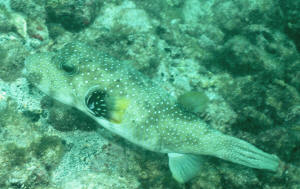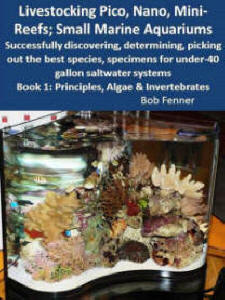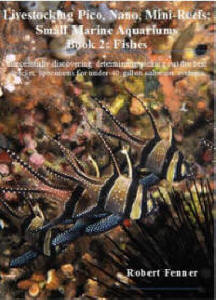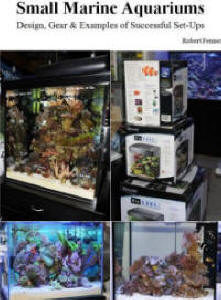|
FAQs about Fish-Only Marine System
Disease
Related Articles: Fish-Only Marine Set-up, FOWLR/Fish and Invertebrate Systems,
Reef Systems, Coldwater Systems, Small
Systems, Large Systems,
Plumbing Marine
Systems, Refugiums, Marine
Biotope, Marine
Landscaping, Fishwatcher's
Guides,
Related FAQs: Fish-Only Marine
Set-ups, Fish-Only Marine Systems 2,
FO System
Set-Ups, FO System Lighting,
FO System Filtration, FO System Skimmers, FO System Livestocking, FO System Feeding, FO System Maintenance, FOWLR/Fish and Invertebrate
Systems, Reef Systems, Coldwater Systems, Small Systems, Large
Systems, Marine System Plumbing, Biotopic presentations,
|

|
 |
 |
 |
Small Marine Aquariums
Book 1:
Invertebrates, Algae
New
Print and
eBook on Amazon:
by Robert (Bob) Fenner |
Small Marine Aquariums
Book 2: Fishes
New
Print and
eBook on Amazon: by Robert (Bob) Fenner |
Small Marine Aquariums Book 3: Systems
New
Print and
eBook on Amazon:
by Robert (Bob) Fenner |
Unknown Parasite in FO Tank Hi there, <<And hello to
you... >> I'm relatively new to this hobby and I believe
I'm encountering my first problem with parasites. The tank is
completely cycled (used 3 damsels and all survived) and all tests are
zero (nitrates are 5). <<as a quick aside, and trying very hard
to not sound lecturing... you should avoid the trend to say "All
tests were zero." They weren't by your own admission.>>
I traded in the damsels and started off with a Coral Beauty and a very
small six line wrasse. I was very pleased to see the angel cleaning up
the algae, which at this point only consists of diatoms! <<You
might consider procuring some algae-encrusted live rock to supplement
the diatoms... surely those will run out.>> After about six weeks
I added a small bird wrasse. About a week later, the Coral Beauty
started scratching on the rocks and began to develop a
"dusty" coating. I immediately treated the tank (with Oomed
by Tetra) because I thought it was probably velvet and I've heard
that you have to act very quickly. Unfortunately, the Coral Beauty
didn't survive the night after adding the meds. This surprised me
because I thought I'd caught it soon enough......he was just as
much of a piggy as usual right up to the day I added the medication.
<<Yeah... that medication [Tetra Oomed] is raved about by some
and shunned by others. It is quite possible the Coral Beauty was done
in by the Oomed and not the Oodinium. And in any case, it is always
better to remove sick fish to a separate quarantine system for
treatment with such medications.>> All the other fish did survive
though and appeared to be doing fine until yesterday. <<Well...
this is the joy of parasitic infections... gone today, here tomorrow.
They have continuing life cycles.>> The other fish have all
started scratching and are now breathing heavy on and off. I'm sure
there's something there but nothing is visible on any of the fish.
All the fish are still eating and acting normally (except for the
breathing and scratching). <<Some fish scratch as part of normal
behavior. If they are damaging themselves by scratching, that for
certain is not normal. How long has this heavy breathing and scratching
been going on?>> I really thought after six weeks that if there
was something there it would have shown itself...............Apparently
not. <<Six weeks after what? The addition of the bird
wrasse?>> What do you suggest I do at this point? Copper, garlic
soaked food, etc.? Any help you can offer would be greatly appreciated.
<<I'm not too hip on garlic as a curative in a situation like
this. Likewise, copper and other harsh medications are best used in a
separate tank or quarantine system. PH adjusted, freshwater dips would
also be helpful, although quarantine will help you catch and then dip
these fish on a regular schedule. You might also want to consider
running the tank fallow [without any fish] for five or six weeks to
bring the parasites back to a more manageable level. Here is some
associated reading: http://www.wetwebmedia.com/quaranti.htm
http://www.wetwebmedia.com/dips_baths.htm
http://www.wetwebmedia.com/parasiti.htm >> Thanks in advance.
Leah Meilleur <<You are welcome. Cheers, J -- >>
Re: Unknown Parasite in FO Tank Hi again, <<Hello
again, hello... ok Neil Diamond I am not.>> OK, here
goes......I'm going to ask for a lot of help here, so please bear
with me. I've read the links (again) that you've suggested and
I'd like to form a step by step plan of action. At the risk of
sounding like a complete idiot, if you could clarify several items for
me I'd be ever so grateful: <<Heh... methinks that idiots are
the ones who don't ask any questions. ;-) >> 1. I have a
spare 10 gallon tank I could use for treatment. However, I'm
concerned that this won't be large enough for the bird wrasse
(4")?!?! <<Yeah, that is a concern. A 20-long would probably
be more suited to this cruiser.>> 2. When I'm filling up the
10, should I be using "new" water or tank water? If I use
tank water am I not bringing more of the problem with me? <<there
are pros and cons, but really more pros as the fish will already be
acclimated to this water. The ease of transition is worth more than the
few parasites that may transfer in the water, and surely more will make
with move on/with the fish. Besides, if you use strong therapies to
treat, all the parasites will be neutralized.>> Alternatively, if
I use "new" water won't the fish be extremely stressed by
the change? <<Ah-ha! I replied too soon. You got it.>> 3.
The links I read over indicated several medications that could be used.
Should I be using copper in the treatment tank or Methylene blue dips
or both? <<depends on just how severe the problem is.>>
I'm really confused here....Is the blue meant to be used only as a
dip or as a long term treatment? <<The M-Blue is best used in the
dip process.>> If I'm to use copper, should it be added
before the fish and then the fish gradually acclimated to the coppered
water? <<Just dose the copper as recommended on the bottle. No
need to acclimate. Kind of like taking aspirin - if you want the pain
to go away now, you need to take two now.>> By the way, I assume
we're talking about COPPERSAFE here? That's the only copper
treatment I've come across. <<That will work fine.>>
Also, will the copper completely eliminate the parasite or is this
likely to be an ongoing problem? <<Well, this is why quarantine
is so useful. If you can treat the fish for a couple of weeks and then
continue the quarantine the fish another two weeks, at the end the fish
will be about as 'clean' as it could be. If you continue the
copper at the recommended dose for the recommended period, you should
eliminate the parasites from the fish and the quarantine tank.>>
4. How long should I leave the "treatment water" in the tank
before beginning to remove the meds via water changes and carbon?
<<For the duration of the treatment. Keep in mind that you
won't have a working biological filter in this tank [the copper
will nuke it] so you will need to do 25% water changes at the very
least every other day. If the bottle says treat for 10 days, then check
the fish after 10 days [like you weren't doing this every day] and
if it is on the mend, feel free to stop the copper and begin the
carbon.>> 5. You've mentioned allowing the main aquarium to
"go fallow" for 6 weeks to bring the parasites back to a more
manageable level. Does this mean that the parasites will still be alive
(I thought they couldn't survive without a host)? <<Well, one
can never be 100% sure without bleaching the system and starting all
over again, which is not the way I'd like to see this go. You can
be certain that the size of the parasite population will be greatly
reduced. And otherwise healthy fish can often endure a parasite or two,
no problem.>> And how are they to be "managed" and kept
at low levels? <<Yes... this is a combination of factors.
Biological cleaners are a great option if your fish won't eat them.
A cleaner shrimp probably won't last around that bird wrasse, but a
neon goby might.
http://www.wetwebmedia.com/marine/inverts/arthropoda/shrimp/cleaner.htm
http://www.wetwebmedia.com/neongobies.htm >> It seems to me as
soon as I put the fish back in, the whole cycle will start again?
<<Not necessarily.>> Is there nothing that will permanently
kill off the little "buggers"? <<Nothing that won't
force you to start all over again - no fun.>> 6. To answer your
question, the on-and-off rapid gilling has been going on for about 3
days now. What's really strange is that one day the fish appear
"different" in that they are hiding, showing difficulty
breathing, and may not eat as much as usual but the next day they
completely "bounce back" to normal behaviour, with the
exception of the scratching......that stays constant since it started a
week ago. <<Hmmm... I've know you've been though it but
you might also look carefully for other things going on in the tank -
chasing, fighting, nipping, large temperature of pH swings, all these
things can cause stress and once stressed, things usually only go
downhill from there.>> I know this was terribly long-winded but I
want to be sure I get this right the first time for the sake of the
fish. Thanks again for sharing your knowledge with us "saltwater
dummies". It seems I've spent half a lifetime reading and
researching this but there's always something new to learn!
<<no dummies here that I can see, only people who want to learn
more, and that's a good thing, as Martha would say.>>
Regards,
Leah Meilleur
<<Cheers, J -- >>
 |
 |
 |
Small Marine Aquariums
Book 1:
Invertebrates, Algae
New
Print and
eBook on Amazon:
by Robert (Bob) Fenner |
Small Marine Aquariums
Book 2: Fishes
New
Print and
eBook on Amazon: by Robert (Bob) Fenner |
Small Marine Aquariums Book 3: Systems
New
Print and
eBook on Amazon:
by Robert (Bob) Fenner |

